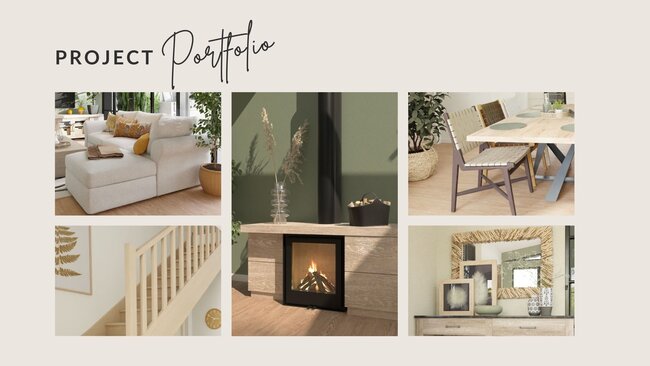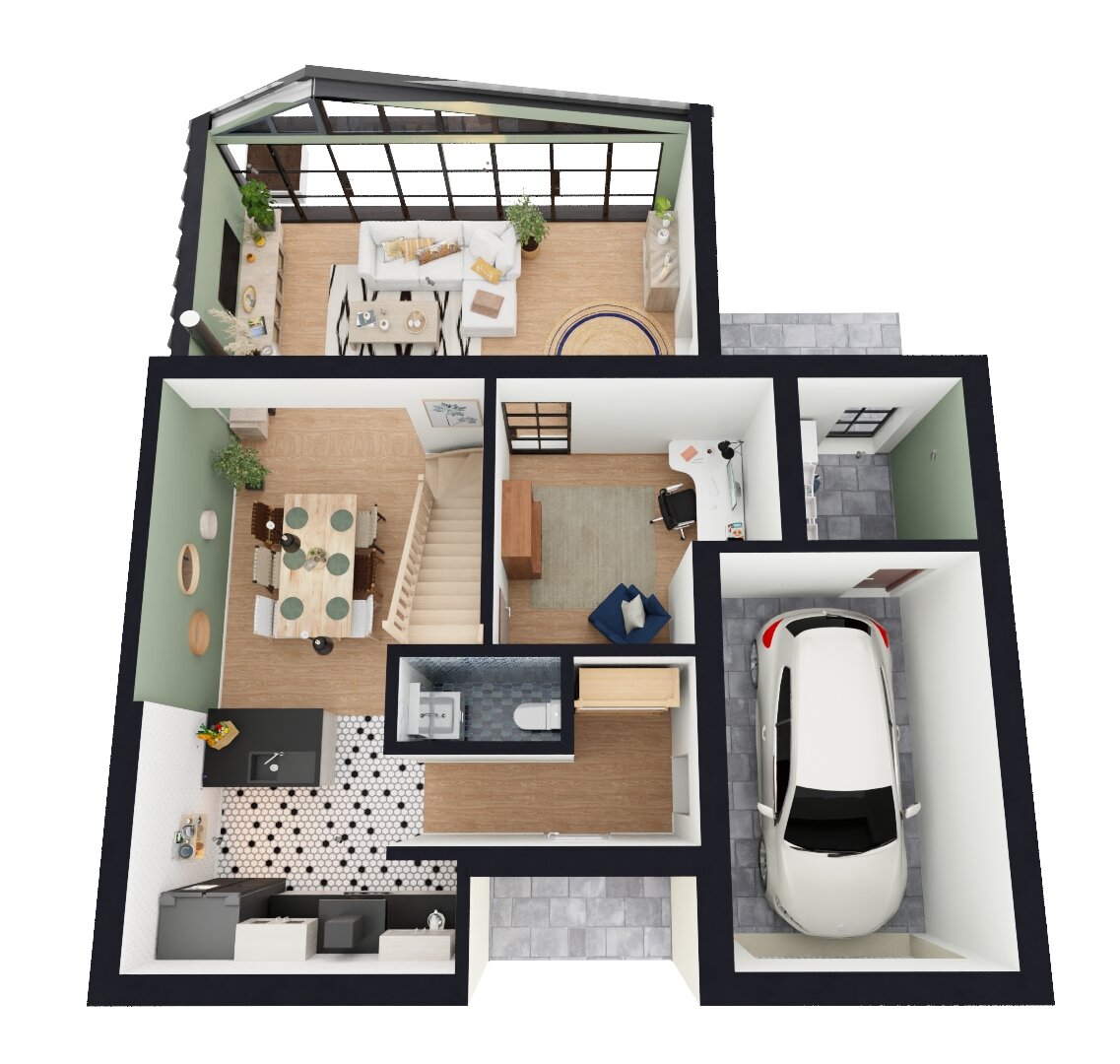In the dynamic world of interior design, the ability to present a cohesive and visually appealing concept is essential. A well-crafted interior design presentation board can do just that.
An interior design presentation board (including elements like design schematics and mood boards) is more than just a collection of ideas — it’s a vital tool that effectively communicates your vision to your clients.
Want some ideas for creating more effective interior design boards?
In this 7-minute read, you’ll get professional tips for creating presentation boards that not only captivate but also clearly articulate your design intentions. From design schematics to mood boards to board layouts, you’ll get the insights you need to take your presentations to the next level.
Let’s start with a quick look at the basics.
What is a Design Schematic / Presentation Board?

An interior design schematic is a visual representation that outlines the key elements and overall concept of a design project. It serves as a roadmap to guide both the designer and the client through the project’s aesthetic, functional, and spatial decisions.
You might be wondering… What’s the difference between an interior design presentation board, a mood board, and a design schematic?
The Answer: It depends on the project and the designer.
- Similarities: They all feature similar elements (color schemes, material and furnishing suggestions, etc.) and in many cases, designers use the terms interchangeably. All three take place during the Schematic Design phase of the project.
- Differences:
- Mood boards tend to be more conceptual than design schematics and presentation boards. On large projects, you use mood boards earlier on in the Schematic Design phase. But for small and simple projects, a mood board could also serve as the final design schematic/presentation board.
- For larger projects, you will likely present multiple mood boards before deciding on a final design style. Then, you present design boards/design schematics which include to-scale floor plans and 3D renderings of the space along with your final recommendations for color palettes, material choices, and furnishings.
Important: In this article, we’ll refer mostly to interior design presentation boards or design schematics. However, the tips also apply when preparing simple mood boards.
Why You Need a Design Schematic
A design schematic or interior design presentation board is a fundamental tool in interior design that outlines the aesthetic and functional vision of a project. It ensures all stakeholders have a clear, unified understanding of the project’s direction. This enables you and your clients to have effective communication and easier decision-making throughout the design process.
Key reasons to use a design schematic:
- Clear Vision Communication: It bridges the gap between abstract ideas and tangible realities and helps to convey your vision to clients, contractors, and collaborators.
- Efficient Planning: By outlining the project’s scope from the outset, a design schematic allows for efficient allocation of time, materials, and labor.
- Issue Identification: Early visualization helps identify potential design or functionality issues. This lets you make adjustments before implementation and saves you time and money.
- Cohesive Design: Ensures every element, from color schemes to furniture placement, works harmoniously towards the intended aesthetic.
- Client Alignment: Facilitates approval from clients by minimizing misunderstandings and revisions thanks to a detailed preview of the proposed design.
Want some tips for creating a stunning presentation board? Check out the next section.
How to Create an Interior Design Presentation Board
Check out these 5 steps to creating a board that conveys your vision and plan to your client.
1. Choose Digital Board vs Hard Board
In the digital age, the choice between a digital board and a hard board is pivotal. Each medium has its unique advantages and can significantly influence the presentation’s impact.
Digital Boards are versatile and easy to share. This makes them ideal for remote presentations or when working with clients across different locations.
They allow for quick edits and updates, ensuring that the presentation can evolve in real time based on client feedback.
Digital boards also let you include interactive elements, such as links to specific products or immersive 3D renderings.
Hard Boards, on the other hand, provide a tactile experience that digital boards cannot replicate.
They’re particularly effective in showcasing textures, colors, and materials since they let clients physically interact with the elements of the design.
Hard boards excel in face-to-face meetings, where the physical presence of the materials makes a stronger impact on the client and fosters an emotional connection with the design.
So which is better?
It depends on the nature of the project, the preferences of your client, and the context of the presentation. Many designers find value in combining both approaches — using digital boards for their flexibility and convenience, and hard boards for their tangible, persuasive power.
2. Choose Your Inspiration
Selecting the right inspiration is an important step in crafting an interior design presentation board that resonates with your vision and appeals to your client.
Here’s how to approach this critical step:
- Explore Broadly: Begin with a wide-ranging exploration. Look at design magazines, online portfolios, and social media platforms like Pinterest and Instagram. This broad approach helps you uncover diverse styles, trends, and innovative ideas.
- Condense Your Ideas: After gathering a broad array of inspirations, start narrowing down your options. Focus on themes, colors, and elements that align with your client’s preferences and the project’s requirements.
- Create a Mood Board: A mood board is an excellent tool for refining your inspiration. It allows you to compile your ideas into a cohesive visual narrative. This can include textures, colors, furniture styles, and architectural elements.
- Client Collaboration: Involve your client in the inspiration process. This collaboration ensures the final board reflects their taste and expectations while fostering a stronger buy-in for the proposed design.
3. Lay Out the Room

The layout of the room is a critical component since it shows how space will be utilized and how different elements will interact within it.
Here are some tips for creating the layout:
- Start with Measurements: Accurate dimensions are key. Ensure you have a detailed measurement of the space, including doorways, windows, and any structural elements that might influence the design.
- Sketch Multiple Options: Don’t settle on the first layout you design. Sketch multiple configurations to explore various ways the space can be organized. This could include different furniture arrangements, traffic flow, and focal points.
- Use Design Software: There are many design software options available that can help you visualize the room layout in 3D. This can be especially helpful for presenting your ideas to clients, as it gives them a more tangible understanding of the space.
PRO TIP! – Go with a powerful, yet easy-to-use design program like Cedreo. It makes it easy for you to create multiple layouts in a matter of minutes. Plus, even with no previous 3D design experience, you can create 3D floor plans and photorealistic 3D renderings that help take your design boards to the next level!
Incorporate Key Elements
- Furniture Placement: Show how furniture will be arranged for both aesthetic appeal and functionality.
- Lighting: Indicate sources of both natural and artificial light, and how they influence the ambiance of the room.
- Flow: Ensure there’s a logical flow between different areas of the room (and between different rooms).
By carefully choosing your inspiration and thoughtfully laying out the room, you create a solid foundation for your interior design presentation board. Now it’s time to add the design elements.
4. Highlight Fabrics, Colors, and Materials
Choosing the right fabrics, colors, and materials is important for conveying the look and feel of your design.
Here’s how to highlight these elements effectively:
- Fabric Swatches: Include samples of the fabrics you plan to use. This could be for upholstery, curtains or cushions. Real swatches attached to a hard board or high-quality images on a digital board let clients touch and feel the textures.
- Color Palette: Use color swatches to visually communicate the color palette that aligns with the design’s mood and style.
- Materials Board: Similar to fabric swatches, include samples or images of key materials like wood, metal, stone, tile or glass. This helps clients understand the quality and finish of the surfaces in their space.
Considerations for Selection:
- Durability: Choose materials that not only look good but are also suited to the space’s function.
- Sustainability: Whenever possible, opt for eco-friendly materials to improve sustainability.
- Harmony: Ensure that all selected fabrics, colors, and materials complement each other to create a cohesive look.
5. Add Furniture & Decor

Furniture and decor play a significant role in bringing your design board to life.
Some tips for adding these elements to your presentation board:
- Furniture Selection: Carefully select furniture pieces that align with the room’s layout, style, and function. Include images or drawings of these pieces on your board to showcase how they contribute to the overall design.
- Decorative Elements: Incorporate decor items such as art, rugs, and accessories. These elements add personality by making it feel curated and lived-in.
- Annotation: Use brief annotations or labels to describe the significance of each piece. Include details about the material or its intended impact on the space.
Considerations for Furniture and Decor:
- Scale and Proportion: Ensure that furniture and decor are scaled appropriately for the space so they maintain balance and proportion.
- Functionality: Choose pieces that not only look beautiful but also serve the functional needs of the space.
- Personal Touch: Include items that reflect the client’s personality or have a special meaning to them. This makes the space uniquely theirs and creates a stronger emotional connection.
Your board is created… Now it’s time to present it. Keep going to the next section for tips on how to do that.
How to Present Your Design Board to Your Interior Design Clients
Presenting your design board effectively is as crucial as the board’s creation itself. It’s the moment where you communicate your ideas with the goal of getting the client on board with your design.
Here are some key strategies for a successful presentation:
- Set the Scene: Begin with a brief overview of the project objectives and how your design meets these goals. This sets the context for the presentation and primes the client for what they are about to see.
- Walk Through Methodically: Guide your client through the board in a logical order. Start with the layout and then move to the color scheme, materials, furniture, and finally…the decor. This step-by-step approach helps clients understand the rationale behind each decision.
- Be Open to Feedback: Encourage questions and feedback. Remember, your presentation is a two-way conversation. Your openness to their input can lead to a final design that truly resonates with the client.
- Visual and Verbal Narration: Use both visual elements on the board and your verbal explanation to tell the story of the design. Emphasize how each element contributes to the overall vision and functionality of the space.
Get Designing with Cedreo Today!
With the right tools, an interior design project becomes an exciting journey of creativity and innovation. Cedreo is here to support you every step of the way.
Cedreo is engineered to meet the needs of remodelers, architects, interior designers, and builders with features like:
- Effortless 3D Modeling: Create stunning 3D models of your designs quickly and easily.
- High-Quality Renderings: Bring your designs to life with high-resolution renderings that are perfect for presentation boards.
- Streamlined Workflow: Cedreo streamizes your design process, from initial concept to final presentation.
Start transforming your design visions into reality with Cedreo today. With a FREE version, you’ve got nothing to lose. Sign up today!



